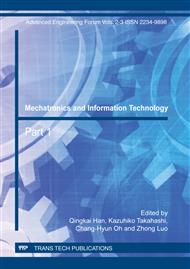[1]
R. B. Randall, A new method of modeling gear faults, ASME Journal of Mechanical Design, 104 (1982) 259-267.
DOI: 10.1115/1.3256334
Google Scholar
[2]
S. K. Lee, P. R. White, Higher-order time-frequency analysis and its application to fault detection in rotating machinery, Mechanical Systems and Signal Processing, 11(1997) 637-650.
DOI: 10.1006/mssp.1997.0098
Google Scholar
[3]
Z. Peng, F. Chu, Application of the wavelet transform in machine condition monitoring and fault diagnostics: a review with bibliography, Mechanical System and Signal Processing, 18(2004) 199-221.
DOI: 10.1016/s0888-3270(03)00075-x
Google Scholar
[4]
I. S. Bozchalooi, M. Liang, A smoothness index-guided approach to wavelet parameter selection in signal de-noising and fault detection, Journal of Sound and Vibration, 308(2007) 246–267.
DOI: 10.1016/j.jsv.2007.07.038
Google Scholar
[5]
W. J. Wang, P. D. McFadden, Application of wavelets to gearbox vibration signals for fault detection, Journal of Sound and Vibration 192(1996) 927–939.
DOI: 10.1006/jsvi.1996.0226
Google Scholar
[6]
C. K. Sung, H. M. Tai, C. W. Chen, Locating defects of a gear system by the technique of wavelet transform, Mechanism and Machine Theory, 35(2000) 1169-1182.
DOI: 10.1016/s0094-114x(99)00045-2
Google Scholar
[7]
J. Lin, L. Qu, Feature extraction based on morlet wavelet and its application for mechanical fault diagnosis, Journal of Sound and Vibration, 234(2000) 135-148.
DOI: 10.1006/jsvi.2000.2864
Google Scholar
[8]
P. W. Tsea, W. X. Yang, H.Y. Tam, Machine fault diagnosis through an effective exact wavelet analysis, Journal of Sound and Vibration 277(2004) 1005-1024.
DOI: 10.1016/j.jsv.2003.09.031
Google Scholar
[9]
G. Gelle, M. Colas, Blind Sources separation: a tool for rotating machine monitoring by vibrations analysis? Journal of Sound and Vibration, 248(2001) 865-885.
DOI: 10.1006/jsvi.2001.3819
Google Scholar
[10]
M. J. Roan, J. G. Erling, L. H. Sibul, A new, non-linear, adaptive, blind source separation approach to gear tooth failure detection and analysis, Mechanical Systems and Signal Processing, 16(2002) 719-740.
DOI: 10.1006/mssp.2002.1504
Google Scholar
[11]
Y. Shen, S. Yang. A new blind-source-separation method and its application to fault diagnosis of rolling bearing, International Journal of Nonlinear Science and Numerical Simulation, 7(2006) 245-250.
DOI: 10.1515/ijnsns.2006.7.3.245
Google Scholar
[12]
S. Qian, D. Chen, Discrete Gabor transform, IEEE Trans on Signal Processing, 41(1993) 2429-2438.
DOI: 10.1109/78.224251
Google Scholar
[13]
J. Wexler, S. Raz, Discrete Gabor expansions, Signal Processing, 21(1991) 207-220.
DOI: 10.1016/0165-1684(90)90087-f
Google Scholar


